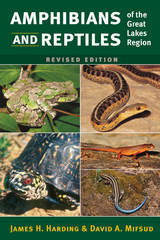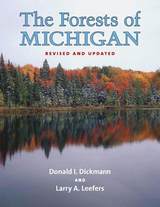3 books about Revised Ed .

Amphibians and Reptiles of the Great Lakes Region, Revised Ed.
James H. Harding and David A. Mifsud
University of Michigan Press, 2017
The revised edition of this well-loved guide is the essential reference for the identification of amphibians and reptiles in the Great Lakes region. Fully updated treatments of over 70 species feature detailed information on the distribution, habitat, behavior, and life history of these fascinating animals. This edition includes all new distribution maps as well as 90 additional color photographs showing close-ups of distinguishing features, common color phases, and different metamorphic stages. A thorough introduction provides a wealth of information on the evolution, natural history, classification, and conservation of these animals and examines changing Great Lakes ecosystems and their impact on herpetological diversity. Amphibians and Reptiles of the Great Lakes Region is a must-have resource for teachers, students, naturalists, professional biologists, and anyone else with an interest in this region’s ecology.
[more]

The Forests of Michigan, Revised Ed.
Donald I. Dickmann and Larry A. Leefers
University of Michigan Press, 2016
Completely revised and updated, this new edition of The Forests of Michigan takes a comprehensive look at the natural history, ecology, management, economic importance, and use of the rich and varied forests that cover about half of Michigan's 36.3 million acres. The book explores how the forests regrew after the great Wisconsin glacier began to recede over 12,000 years ago, and how they recovered from the onslaught of unrestrained logging and wildfire that, beginning in the mid-1800s, virtually wiped them out. The emphasis of the book is on long-term efforts to sustain the state’s forests, with a view of sustainability that builds not only upon the lessons learned from native peoples' attitude and use of trees, but also on the latest scientific principles of forest ecology and management. Generously illustrated and written in an engaging style, The Forests of Michigan sees the forest and the trees, offering both education and delight.
[more]

The Woman Who Knew Too Much, Revised Ed.
Alice Stewart and the Secrets of Radiation
Gayle Greene
University of Michigan Press, 2017
The Woman Who Knew Too Much illuminates the life and achievements of the remarkable woman scientist who revolutionized the concept of radiation risk. For more than 40 years, Alice Stewart (1906–2002) warned that low-dose radiation was more dangerous than anyone acknowledged. In the 1950s she discovered that fetal x-rays double a child’s risk of developing cancer. Two decades later, in her 70s, she again astounded the scientific world by showing that the U.S. nuclear weapons industry was about 20 times more dangerous than safety regulations admitted. This finding put her at the center of an international controversy over radiation risk. In 1990, the New York Times called Stewart “perhaps the Energy Department's most influential and feared scientific critic.”
Author Gayle Greene traces Stewart's life and career as she came up against ever more powerful authorities, first the British medical profession, then the U.S. nuclear industry, and finally the regulatory agencies that set radiation safety standards throughout the world. Stewart endured the fate of other women scientists in having her findings dismissed and funding cut, but today is recognized as a pioneering figure in epidemiological research on the dangers of nuclear radiation. In her preface to the second edition, Greene looks at new information that’s come out about the forces and individuals responsible for marginalizing her as a scientist and downplaying the disturbing implications of her research.
Author Gayle Greene traces Stewart's life and career as she came up against ever more powerful authorities, first the British medical profession, then the U.S. nuclear industry, and finally the regulatory agencies that set radiation safety standards throughout the world. Stewart endured the fate of other women scientists in having her findings dismissed and funding cut, but today is recognized as a pioneering figure in epidemiological research on the dangers of nuclear radiation. In her preface to the second edition, Greene looks at new information that’s come out about the forces and individuals responsible for marginalizing her as a scientist and downplaying the disturbing implications of her research.
[more]
READERS
Browse our collection.
PUBLISHERS
See BiblioVault's publisher services.
STUDENT SERVICES
Files for college accessibility offices.
UChicago Accessibility Resources
home | accessibility | search | about | contact us
BiblioVault ® 2001 - 2024
The University of Chicago Press









